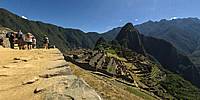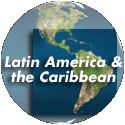The central buildings of Machu Picchu use the classical Inca architectural style of polished dry-stone walls of regular shape. The Incas were masters of this technique, called ashlar, in which blocks of stone are cut to fit together tightly without mortar. Many junctions in the central city are so perfect that it is said not even a blade of grass fits between the stones.
Interior of an Inca building, featuring trapezoidal windows The section of the mountain which Machu Picchu was built on provided several beneficial and detrimental factors. The most apparent detriment was that Machu Picchu was built between two fault lines. This location also frequently received heavy rainfall; this meant that land and mud slides in the area were also common. The Inca needed a solution to these detriments, and Machu Picchu would offer everything they needed.
The seismic activity which is caused by being between two fault lines led the use of mortar and other such building materials to be nearly useless. However, the Inca developed a successful method which allowed the construction of Machu Picchu to be possible. The site offered a natural quarry which was used to construct the over 200 buildings which would sit on the mountaintop. The stones harvested from this quarry were lined up, and shaped to perfectly fit together in a manner which would supply a more sturdy method than mortar would have. However, the Inca would also use the chips which they carved off of the stones in their construction and as a method to avoid mud and landslides, as well as flooding.
These stone chips were used in the terraces and in the large courtyard in the center of Machu Picchu. The terraces were used chiefly to drain and syphon the water from rain, as well as to hold the mountain in place. Each terrace was multi layered: first top soil, then dirt, sand and finally stone chips. This meant that water which sat on the terraces would sift downward into the mountain, as opposed to overflowing and running down the mountain.
The large center area of Machu Picchu also had a system similar to this in place which, again, assisted the main inhabited portion of Machu Picchu from flooding.
Inca walls had numerous design details that helped protect them against collapsing in an earthquake. Doors and windows are trapezoidal and tilt inward from bottom to top; corners usually are rounded; inside corners often incline slightly into the rooms; and "L"-shaped blocks often were used to tie outside corners of the structure together. These walls do not rise straight from bottom to top, but are offset slightly from row to row.
The Incas never used the wheel in any practical manner. Its use in toys demonstrates that the principle was well-known to them, although it was not applied in their engineering. The lack of strong draft animals, as well as steep terrain and dense vegetation issues, may have rendered the wheel impractical. How they moved and placed the enormous blocks of stones remains a mystery, although the general belief is that they used hundreds of men to push the stones up inclined planes. A few of the stones still have knobs on them that could have been used to lever them into position; it is believed that after the stones were placed, the Incas would have sanded the knobs away, but a few were overlooked. [Wikipedia]
Music “Peru” by Marco Raaphorst. Creative Commons Non Commercial Share Alike License.
Lat: 14° 10' 55.89" S
Long: 73° 33' 44.6" W
Elevation: 8374'
Precision is: High. Pinpoints the exact spot.




 Tap or click the zoom icon in the bottom right corner of the picture to switch between in-page and fullscreen view
Tap or click the zoom icon in the bottom right corner of the picture to switch between in-page and fullscreen view